Apartments, flats, and walk-ups provide housing for a huge percentage of the world’s population in cities around the globe. But did you know that shipping containers can and have been used to build incredible apartments?
If you’re looking for a home rental, you typically want something that’s more affordable than a free-standing house, with the flexibility to stay for months instead of years, and have less upkeep while you live there.
As it turns out, shipping container apartment rentals offer all these benefits and more. They’re certainly worth considering for your next home or even as a real estate investment.
In this article, we’ll go into more detail about container apartments which includes showing you some incredible examples, so read on!
What is a Shipping Container Apartment?
Simply stated, a container apartment is an apartment that takes advantage of shipping container architecture. But within that definition is a lot of variability.
Some container apartments are two to three-story midrises, while others are seven floors high! Some apartments use a single shipping container as the footprint for a unit, while others have a floorplan that spans across multiple containers.
Note that in many places, structures higher than three stories will fall under the commercial portion of the building code. If you’re building a container apartment complex that’s three floors or less, you can probably get approved under the residential code.
Additionally, you have the purpose of the container apartments to consider. Some of them are built with containers purely as a way to get a lower price of construction. Others utilize containers because the project is only temporary in nature and will eventually have to be moved. And then, there are some apartment complexes that use shipping containers mostly because of their aesthetic qualities.
When you consider apartments built from shipping containers, you face many of the same benefits and drawbacks that affect other container home owners. However, there are some unique aspects as well.
We’ll do our best to consider those of you who may be interested in building or investing in container apartments, as well as those who are just interested in living in one!
Benefits of Container Apartments
There are a lot of great reasons to consider shipping container apartments, so let’s jump right in!
Faster to Build
Most container apartments take advantage of a modular construction process, where the containers are at least partially modified offsite. After that, each container is brought to the project site where they are assembled, connected, and finished. This concept impacts speed in two ways.
First is the result on the overall project timeline. Off-site modifications can be done in a factory which leads to speed (and quality) improvements. There’s no weather to worry about, no working at heights, and no tools that go missing. You don’t have to bring in specialty workers from out of town. It’s many of the same reasons that cars are built on a factory assembly line instead of being custom-built by hand.
The second way speed is a factor is through reducing on-site work. With the majority of the work taking place in a controlled environment, there are many fewer activities occurring on-site. This speeds up the amount of time that the project appears to be under construction, and greatly minimizes neighborhood impacts like road closures, noise, and dust, for example.
If you’re a prospective container home resident, why would you care about these things? Two reasons.
First, many apartment complexes are built with expansion in mind. If they perform well and have good occupancy, owners may add additional units. If you’re already living there, it’s in your interest for any expansion to be as low-impact to your daily life as possible.
Second, time is money as we all know. And if the builder is moving faster and saving money, it’s reasonable to expect that your rent may be cheaper as well compared to traditional apartments.
Cost-Effective
The increased speed mentioned above ties directly into the cost of construction, though it isn’t the only factor. The very nature of containers can also lead to additional cost savings.
For instance, given the structural strength of shipping containers, a less expansive foundation is required to support it. This, in turn, will be cheaper to build.
It’s obvious that containers include walls and a roof as part of their original configuration for transporting goods. Depending on the design, those elements will be retained on either the interior or exterior of the apartment unit. This too can save money.
Containers also make it easy to enact a minimalism ethos in apartment design. Having fewer things in the apartment, and making those things in a way that focuses more on function than aesthetics leads to reduced costs as well. When you’re starting with a building block that exudes industrial design, incorporating this thinking isn’t a big leap.
Toughness
One of the fundamental benefits of a shipping container is its strength and durability. When applied to an apartment building, this attribute is as impactful as always.
For instance, you can feel safe in a container home knowing people with bad intentions are going to have their hands full trying to get inside. That’s doubly true if the container complex employs some common-sense security measures.
And when mother nature sends inclement weather, you don’t have to worry about your building turning into splinters. Shipping containers are made of an extremely tough, weathering steel that’s made to survive through rough seas and storms while keeping cargo protected.
Semi-Permanent
A shipping container’s portability is what enables the modular construction process we talked about earlier. But you may be thinking, “I don’t want my apartment to be portable at all, I want it to be solid and secure.”
Well, we’re here to tell you that shipping containers can be all of those things at the time. Notice the eight corner fittings on a typical shipping container. By holding just those eight points and nowhere else, a shipping container can be completely and totally immobilized. Why does that matter?
The ecosystem of shipping container tools and equipment includes special locking devices called twist locks that are used to tie containers to each other when they are transported at sea, rail, or road. Using these same types of devices on a container apartment means that a completely structurally integrated building can be deconstructed quickly and simple if needed.
Now, that’s not something your average apartment renter wants or cares about, but it could be appealing for some landowners. For instance, if you have long term plans for a more permanent building, but want to generate rental income in the short term, containers are worth a look.
You can economically gain vertical construction, then later the building to another site without an unreasonable amount of work. This is a benefit that is only useful to a limited few, but it’s one that traditional construction just can’t match in almost any way. More often than not though, container apartments end up being welded together to make them fully permanent.
Eco-Friendly
In this day and age, concern for the environment is not just a fringe idea. People everywhere are trying to reasonably reduce their impact on the earth.
It’s driving consumer decisions on everything from which consumer products to buy to how to travel. And housing is no different.
As a renter, all other things being equal, you’d probably prefer an apartment made of recycled materials. Something that’s built well so that it won’t need to be torn down in just a few years and replaced due to wear and damage.
Shipping containers offer the opportunity of sustainability, though not the promise of it. By that, we mean that you can still build a container apartment in a way that is not at all considerate of the environment. But by being conscious in the design and construction, container apartments can be quite eco-friendly.
Architecturally Interesting
Even though container apartments are built of ‘boxes’, they don’t have to look like a giant box themselves. In fact, you can make the floor plan look almost any way that you want.
In many ways, shipping containers are almost like LEGO bricks. They can be stacked, turned, and combined in numerous creative ways. With different types of cladding, you completely hide the container’s metal skin or choose to highlight certain parts of it.
And even within the confines of an individual container’s interior, you can move rooms around to completely change how the living space is used.
In short, containers offer an incredible variety of both interior and exterior design possibilities. Even if none of the other benefits appeal to you, this one just might.
Everyone wants to live in a place they are proud of, that sparks conversation, and that makes them smile when they see it every day. A shipping container apartment, if designed well, can offer exactly that.
Drawbacks of Container Apartments
Container apartments aren’t the perfect solution for everyone. And while living in one won’t be nearly as bad as the humorous picture below depicts, there are some negatives to consider. The good news is that most of the negatives can be addressed and mitigated.
Ceiling Height
Even with a high cube shipping container, you’ll have an interior ceiling height of 8 ft 10 inches at most. And remember that any additional flooring and roof insulation on the interior of the container will only reduce that.
With that said, most standard construction houses are built with 8 ft ceilings, so you aren’t really missing anything. But if you’re hoping for a soaring multistory living space, for example, you’ll have to do some creative designs with stacked containers.
Interior Width
Just a quick glance at a shipping container lets you know that it’s pretty narrow. Overlooking less common options like pallet-wide and 48/53 ft varieties, most containers have an interior width of 7 ft 8 in. As above, that’s before you add any interior walls or insulation, which will bring you much closer to 7 ft.
It’s a width that is tight but certainly livable with a creative design for 1 or 2 people. Add a few other family members into the mix, or just a desire for a little more room, and you quickly run up against the physical realities of shipping containers.
Luckily, all is not lost. It’s not only fairly simple but also quite common to cut out part (or all) of the wall between two adjacent containers and make wider rooms. Container apartments that are larger than efficiencies, or marketed towards higher-end renters, will most certainly incorporate space from multiple containers.
Insulation Location
The fact that container walls are made of the strong, corrugated steel mentioned previously does create an issue for apartment construction. The corrugations provide enough strength that wall studs aren’t needed for an unmodified container to have tremendous cargo strength.
However, without wall studs, there is no cavity between those studs to place insulation. This is why most container home and apartment builders end up adding interior studs and insulating there. Even if you insulate on the exterior of the interior, you’ll still need furrings strips to mount the exterior cladding and retain a space for the insulation.
Neither of these options is especially bad, but they do mean that some additional work is needed to incorporate insulation into a container building.
Container Apartments Options and Alternatives.
If you think of a container apartment more broadly as a multiunit modular structure, you start to see several options and closely related alternatives. Below we’ll go over a few of these container apartment variations.
Temporary Workforce Housing
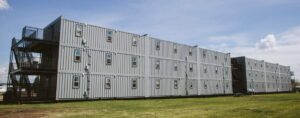
While most people work in cities or communities, there are some jobs that are located far from population centers. Examples of this include natural resources industries like mining and petroleum, scientific research, as well as military operations.
While we often think of the sometimes dangerous work these men and women do, we often forget about the logistics of having them there in the first place. One of the primary problems to solve is where to sleep and relax during off periods.
The expectation for most of these projects is that they will last for months or even years, but at some point, they will be over. Therefore, it doesn’t make sense to build permanent housing in these situations.
Instead, modular living quarters are brought on-site for workers. Some of the units are made of shipping containers while others are purpose-built modules, but the result is fairly similar.
Affordable Housing
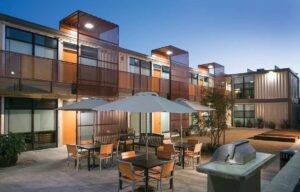
Organizations and non-profit groups around the world have been embracing shipping containers. The boxes provide a way to economically create housing for homeless and low-income populations.
And just because the occupants aren’t rich doesn’t mean their housing has to be cheap. Many of these shipping container complexes are functional AND beautiful.
Yes, these low-income housing units are built by groups and rented by individuals that have different motivations than typical container apartment stakeholders, but they often don’t have many practical differences other than size.
Student Housing

Student apartments on or near universities is another use-case when container construction can really shine. With limited budgets and lower expectations, most students are happy to live in container-based micro apartments that are smaller than what’s preferred by the average working adult.
Containers offer a way to provide dense housing at a more affordable price than other alternatives, while still being aesthetically pleasing and liveable.
Modular Apartments
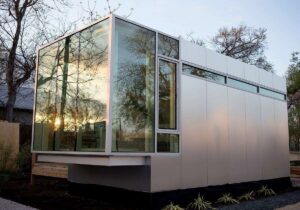
The last category we’ll cover isn’t actually built with containers at all. Numerous companies around the world make prefabricated housing structures that are often confused for shipping containers.
But despite being large boxes, these prefab housing units have no connection to shipping containers. That’s not to say they can’t be wonderful. In fact, in some ways, they can be superior.
Uncoupled from the size constraints of containers, these bespoke units can be wider and taller than typical containers. This makes them more easily accepted for human habitation without having to modify and combine them.
However, in exchange for the size and design flexibility, you give up the compatibility with the transportation infrastructure associate with containers. Additionally, these units build with prefab construction usually end up being pretty expensive and aren’t nearly as strong as traditional shipping containers.
Examples of Container Apartments
We’ve talked about the background information of container apartments long enough and now it’s time to show you some from around the world!
600 Berry Street Apartments
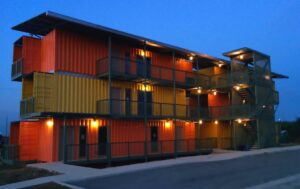
This beautiful apartment building is located in Encinal, a small community about 100 miles south of San Antonio, Texas. The building consists of 12 containers stacked on three levels to form seven apartments of different sizes.
Units include studio, one-bedroom, and two-bedroom layouts. All the units have access to the common exterior walkway/porch as well as private balconies.
Protection from the hot, Texas sun comes in the form of a large sloping roof.
Driveline Studios
Sitting inside South Africa’s capital and biggest city Johannesburg is Drivelines Studios. This huge, bold apartment complex is spread across two seven-story banks set in a V-shape for a total of 140 containers. Immediately noticeable are the angular cut-outs and painted stripes across the sides of the buildings.
The inward face side of each bank of containers consists of a porch/walkway that’s shared among all the apartments on the same level. This space is actually made from containers as well but is kept open-air with cutouts.
The interiors are, as the name suggests, small studio apartments. Most of the units are made of two adjacent 20 ft sections of 40 ft containers for a roughly 16 ft by 20 ft studio. A few of the studios at the ends of the building utilize a 3rd 20 ft section to get a larger interior space of 24 ft by 20 ft.
Cube Square Apartments
Another container apartment complex from Texas, this time in the city of Huntsville. The Cube Square apartments are located nearby Sam Houston State University but serve students and non-students alike.
Consisting of two buildings with four levels, the complex is quite a sight in an otherwise small town. Each building is made from 12 45 ft high-cube containers, with three on each level split into two 540 square foot units.
The builders opted to use rigid closed-cell polyurethane panel insulation on the outside of the containers. Colorful sheet metal cladding was then placed on top of the insulation to give the final exterior finish. Large windows are incorporated into both ends of each container, casting natural light throughout the interiors.
SeaUA Container Apartments
Washington D.C.’s Brookland neighborhood is home to this complex of container apartments. The owners opted for an unusual configuration that sets these units apart.
The building has two sets of nine containers on each end, with three floors of three containers each. There is also a ground-level that slightly below grade made of concrete. Each container has a bedroom and bathroom.
In between the two banks of containers on each level are a shared restaurant-style kitchen and open area living room. This arrangement helps provide a sense of community among occupants. It also keeps rents lower while providing higher quality cooking and entertaining spaces since the cost is shared.
Cité a Docks
The Cité a Docks student apartment complex in Le Havre, France is another famous example of container construction. Built four stories tall, it contains numerous openings for staircases and breezeways along with covered bicycle parking under some of the units.
With 100 individual container apartments made just as many containers, plus container amenities areas as well, the complex is quite large. However, the apartment themselves are small given they each fit inside a 40 ft container.
The Oscar
Set in Phoenix’s West Evans Churchill Neighborhood, The Oscar is a community of ten apartments and two retail spaces. In total, 24 shipping containers were used in the project. The first floor uses 40 ft units while the second and third floors are 45 ft containers.
The design consists of three banks of containers stacked three-high and separated by two contrasting building areas. These spaces include concrete block structures that house the bathrooms as well as the stairs to access the upper floors.
One unique touch is that the paint has mostly been removed to expose the Cor-Ten steel underneath. This steel develops a light, permanent rust-colored patina that protects it from further corrosion. In most situations, it’s still advisable to have paint, but in the hot, dry climate of Phoenix, this works well.
Containers on Grand
Containers on Grand was created by the same architecture firm that designed The Oscar and is located in the same city, Phoenix. It consists of 16 shipping containers that are 40 ft long.
Unlike The Oscar, Containers on Grand is only two stories tall and consists of eight residences. However, similar to The Oscar, each apartment consists of two adjoined containers with most of the walls removed, plus a bathroom in a concrete block structure between banks of containers.
Due to using 40 ft instead of 45 ft containers, Containers on Grand apartments have slightly less interior square footage but otherwise have fairly similar designs that make no attempt to hide the beautiful, industrial origins of their shipping containers.
Summary
Shipping container apartments are a great way to embrace the future of real estate with properties that are bold, functional, and resilient. While there are cons to container housing, the pros make these multifamily structures appealing.
As you’ve seen from the numerous examples we highlighted, there are almost as many use cases are there are design possibilities.
Have we overlooked a significant container apartment complex? Have you ever lived in one? Let us know your thoughts in the comments below.

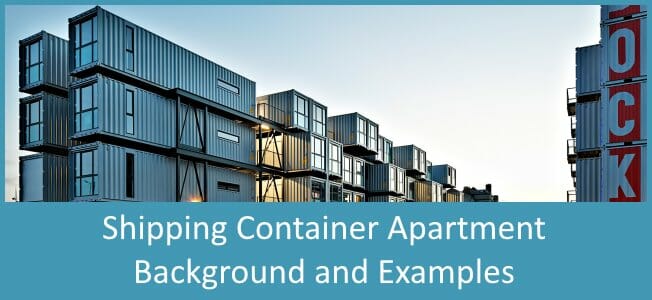



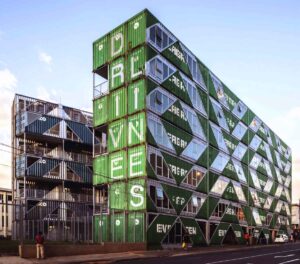
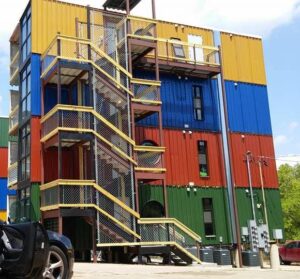
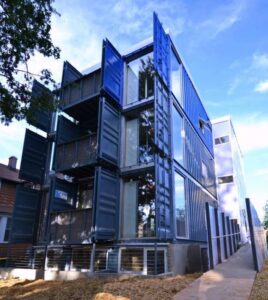
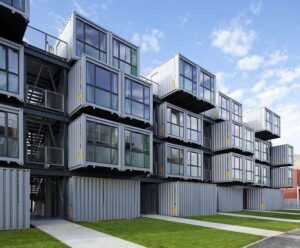
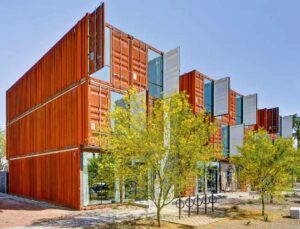
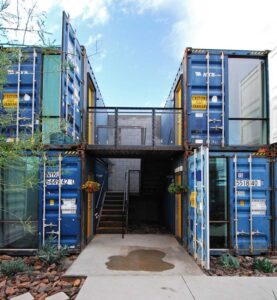

10 Responses
Ciao, bello quest’articolo. Mi piacerebbe costruire una costruzione su palafitte con questi container. Posso avere qualche idea progettuale da valutare???
We don’t offer custom design services at this time, but feel free to browse through the many example container projects in our database here, then head over to our Professionals listings (https://www.discovercontainers.com/professionals/) to find a designer/builder.
Very good article outlining the pros and cons of MultiFam container properties. As an investor, this construction strategy is intriguing to me. I’m very interested in constructing a triplex or fourplex container property. I have more research to do, but this article is a good start. Thanks!
Glad it was helpful! Make sure you check out the Multi-Family Residential section of our Container Project Database for a few other similar projects: https://www.discovercontainers.com/project-types/multi-family-residential/
I love this article and am “all in” on a multi-family container project. I’m wondering how complete the containers would be when they arrive. Is there a company that pre-fabs the containers? I would be adding them to a property that has an existing building on it. How do I go about getting an estimated cost of such a structure? Thank you so much!
How complete the containers are is up to you and your builder. Depending on the location and logistics, it may be more simple and more economical to do the majority of the construction at the builder’s factory, with minimal onsite work including assembly and hookups. Or you could rough shells made with window/door cutouts, but handle most of the interior work once on site. And if you wanted, you could just have empty containers brought on-site and do all modification and construction at the building site. Check out our ‘Professionals’ listing here https://www.discovercontainers.com/professionals/ to find companies that might be able to help. As far as cost, for a larger multi-family project, you’ll need to work with the contractors to develop an estimate. Our cost-estimating tool https://www.discovercontainers.com/cost-calculator/ can be used, but with these larger projects, the variability is so large that you really need to do a one-off estimate specific to your project.
Hi, I really enjoyed reading your article, I’d like to h build the students apertments using shipping containers. Three storey building with 70 rooms per floor, is it possible that you estimate on how many containers I will need for that kinda building? Im really impressed by your article. Ty Kagiso Ratsaana
Just depends on the size you’d want for each apartment, plus the common areas needed like hallways, stairs, utility closets, shared laundry facilities, etc. But if you know the sizes of rooms you need, it’s simple math. You can view the floor sizes of the most common containers here and figure out how many you need: https://www.discovercontainers.com/shipping-container-dimensions/
Hi, enjoyed reading this massive article. I would love to have the opportunity to build my own place using one or 2 shipping ctrs. I believe there was a small office bldg. In prov. R. I. Maybe 4 sc’s painted in primary colors, it fascinated me, I think it was dismantled, sadly, I liked cing it from freeway. Sc’s are probably in providence port authority awaiting for a home to b built in it. Putting it on land in R. I, that’s the ? Ty, Tina Lopez
Thanks for reading, Tina. As far as we know, the Box OFfice still exists in Providence, if that is what you are referring to: http://www.boxoffice460.com/